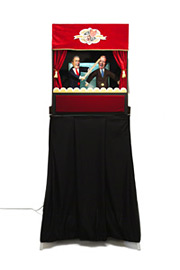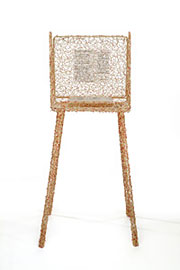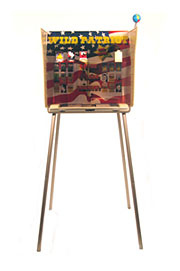Art in the City: The Voting Booth Project
 Voting Machine by Alexander Isley
Voting Machine by Alexander Isley
Photo: © Michael Moran
 Voting Machine by David Rockwell
Voting Machine by David Rockwell
Photo: © Michael Moran
 Voting Machine by James Polshek
Voting Machine by James Polshek
Photo: © Michael Moran
Having voted only by absentee ballot and lever machines in the past, I had never seen a Votomatic voting booth – the punchcard machine made famous in the 2000 Presidential election in Florida – up close. That is, until last Friday at the Parsons School of Design art gallery on West 13th Street, where I saw 50 of them in The Voting Booth Project, all dressed up and making a statement.
The first thought that struck me as I saw the three long rows of Votomatics – purchased on Ebay and donated by famous hotelier Andre Balazs to artists, architects, and musicians who turned them into pieces of art – was their sheer delicacy. Each machine is nothing more than a small suitcase on four slender aluminum legs. It is remarkable that something so small and fragile in design was responsible for such an intense conflict in the last presidential election and affected America’s democratic process in a major way.
The gallery was filled with an eerie juxtaposition of noises from several of the mixed-media pieces. In the corner, a loud ticking sound emanated from Yeohlee Teng’s piece, a closed voting booth sitting on the ground entitled, “Unattended,” while the cheery notes of “Colonel Bogey March,” reminiscent of parades and political rallies, blared on repeat from another piece. (And of course, this is still New York, there was the occasional ringing cell phone.)
Whether the artists used drawings, paint, photographs, graphics, sculpture, textiles, or video to transform their Votomatic, one thing all the pieces had in common – other than starting with the same object – was the intent to make a political statement, overwhelmingly against the current administration.
There was Michael Bierut and James Biber’s “Crushed” in which a 1.5 ton steamroller had crushed their Votomatic into silvery metallic sheets of rubble. Perched on top of the flattened machine was a miniature plastic toy elephant.
Others seemed to be making more of a statement on the American democratic process or the importance of having a reliable voting system. Architect David Rockwell’s “Playing with Fire” piece featured a Votomatic built to scale, composed entirely out of thousands of matches glued together, with voting instructions made of rice paper. Next to his piece a small sign read, “Voting is a fundamental right of democracy and must be handled with care.” For his “Palm Beach Playhouse,” Alexander Isley turned a booth into a miniature puppet playhouse, complete with red velvet curtains and George W. Bush and Al Gore puppets, posed so that the former is hitting the latter in the face with a baseball bat. A sign beneath the puppets reads, “The 2000 election was a true theatrical experience. This piece attempts to recreate the dramatic tension, nuance, and statesmanship reflected in the American electoral process and the performances of that year.”
While some of the machines, like “White Voting Booth” – which looked exactly as it is described – gave little explanation and left much to the imagination, others tried to be clever, funny, or facetious. For his piece “What Happens in Vegas Stays in Vegas,” James Stewart Polshek turned his voting booth into a slot machine, with pictures of Bush, Kerry, Nader, the liberty bell, oil rigs, and maps of the United States spinning before the onlooker. The accompanying commentary reads, “‘What Happens in Vegas Stays in Vegas’ is an expression of both optimism (embodied in the spirit of gambling) and of fear that the upcoming election will become another farce preventing a desperately needed change.”
With controversy arising this year over the design and potential electoral impact of electronic voting machines, The Voting Booth Project drives home the fact that the design and style of democratic tools do and will affect the democratic process itself. Every booth in the exhibit serves as a voice in this year’s political environment, engaging the artists and the viewers in the continuing dialogue over how best to conduct voting in American democracy.
The Voting Booth Project will be on display through Nov. 15 and is free and open to the public. Selected works from the exhibit will be auctioned off at a silent auction on Oct. 27. Proceeds will benefit Parsons School of Design and Declare Yourself, a national non-partisan, non-profit campaign dedicated to energizing and empowering young voters. For more information on The Voting Booth Project and the silent auction, visit the Parson’s web site.
![]()
